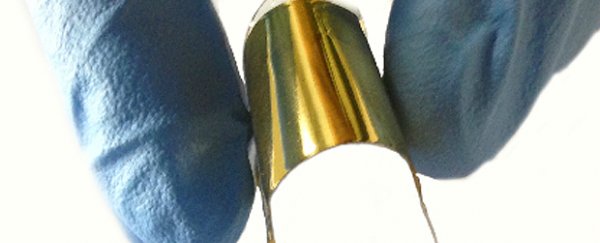It's official - technology can now use us to power itself. And we're not even mad about it.
Developed by researchers from the National University of Singapore, this tiny, flexible patch can harvest static electricity from your movements, and use that energy to power small electronic devices - think a Fitbit or an iWatch.
The device is so resourceful that a stamp-sized patch of it can generate 7.5 V of electric potential simply from you talking or flexing your fist. If you tap it, it can generate a maximum of 90 V of open circuit voltage and 0.8 mW - enough power to light up 12 commercial LEDs, as Prachi Patel reports for IEEE Spectrum.
Demonstrated by engineering professor Chengkuo Lee at the IEEE International Conference on Micro Electro Mechanical Systems (MEMS) 2015 in Portugal in January, the patch can already successfully be used as a wearable, self-powered sensor that tracks the wearer's activity and movements throughout the day.
And when scaled up, this kind of generator could be used to create new types of wearable electronics that don't need a battery, and are charged by the wearer walking, talking or holding objects. As long as you don't stay still for too long, you'll never have to run out of battery again.
The device works by collecting static electricity - the type of electricity that makes your hair stand on end when you rub a balloon on it - and it then converts this mechanical energy into electrical energy. This is a phenomenon known as the triboelectric effect, and, unlike piezoelectric materials, which generate electrical energy when put under stress, this effect requires two different surfaces being put into close contact to generate static.
When these two materials are then pulled part or flexed, a potential difference is generated and a current flows between the two materials, which can be collected using an electrode, as Patel explains.
In the case of the device, Lee and his team created a material out of thousand of tiny pillar-like structures, stuck onto a flexible silicon layer. These little pillars increase the surface area of the material, which means it can generate more friction.
And the material that it rubs against? Our skin.
"Skin, the most abundant surface on a human body, is a natural choice for one of the triboelectric layers," Lokesh Dhakar, Lee's graduate student, told IEEE Spectrum.
"Also skin as a triboelectric material has a high tendency to donate electrons or get positively charged which is important in improving the performance of the device if the other triboelectric layer intentionally chosen as the one with a tendency to get negatively charged."
The patch is backed by a 50 nm-thick layer of gold, which acts as an electrode to collect all of that static electricity. So, to be fair, the technology isn't sucking anything out of us, it's just using our friction to power itself.
The team has now tested the patch by attacking it to a wearer's throat or forearm, and have shown it can successfully generate enough electricity to power a sensor.
They're not the first to build a device like this - in 2013, a team from the US developed a triboelecric generator that was much bigger and far more powerful. But it used indium tin oxide as the electrode, which meant that the whole thing was far less flexible.
By improving how well these kind of devices move, the Singapore-based researchers are hoping they can make devices that can be integrated into wearable technology and also scaled up. Eventually it's hope they'll be able to use the material to charge larger devices - think mobile phones and potentially even laptops - simply by rubbing against our skin.
Source: IEEE Spectrum
